Different Responses in Induction of Allergen Specific Immunoglobulin G4 and IgE-Blocking Factors for Three Mite Subcutaneous Immunotherapy Products
- PMID: 27593871
- PMCID: PMC5011275
- DOI: 10.3349/ymj.2016.57.6.1427
Different Responses in Induction of Allergen Specific Immunoglobulin G4 and IgE-Blocking Factors for Three Mite Subcutaneous Immunotherapy Products
Abstract
Purpose: Specific immunoglobulin G4 (sIgG4) and immunoglobulin E (IgE)-blocking factors produced by subcutaneous immunotherapy (SCIT) play a critical role in the induction of allergen tolerance. However, comparative studies of available SCIT reagents on the induction of sIgG4 are limited. We compared increases in sIgG4 for three different house dust mite (HDM) SCIT reagents.
Materials and methods: Seventy-two HDM sensitized allergic patients were enrolled and classified into four groups: 1) control (n=27), 2) SCIT with Hollister-Stier® (n=19), 3) Tyrosine S® (n=16), and 4) Novo-Helisen® (n=10). Levels of specific IgE (sIgE), sIgG4, and IgE blocking factor to Dermatophagoides farinae (D. farinae) were measured using ImmunoCAP (sIgE, sIgG4) and enzyme-linked immunosorbent assay (ELISA) (IgE-blocking factors). Levels were measured before and 13.9±6.6 months after the SCIT. The allergen specificity and the induction levels of sIgE and sIgG4 were confirmed by immunoblot analysis.
Results: After SCIT, sIgG4 levels to D. farinae increased significantly; however, the increases differed significantly among the SCIT groups (p<0.001). Specific IgG4 levels to D. farinae were highest in Hollister-Stier® (3.7±4.1 mg/L), followed by Novo-Helisen® (2.2±2.3 mg/L) and Tyrosine S® (0.7±0.5 mg/L). In addition, patients who were administered using Hollister-Stier® showed the most significant decrease in IgE/IgG4 ratio (p<0.001) and increase in blocking factor (p=0.009). Finally, according to IgE immunoblot results, the Hollister-Stier® group showed the most significant attenuation of IgE binding patterns among others.
Conclusion: Currently available SCIT reagents induce different levels of specific IgG4, IgE/IgG4 ratio, and IgE-blocking factor.
Keywords: Blocking factor; IgG4; house dust mite; immunotherapy; specific IgE.
Conflict of interest statement
The authors have no financial conflicts of interest.
Figures




References
-
- Burks AW, Calderon MA, Casale T, Cox L, Demoly P, Jutel M, et al. Update on allergy immunotherapy: American Academy of Allergy, Asthma & Immunology/European Academy of Allergy and Clinical Immunology/PRACTALL consensus report. J Allergy Clin Immunol. 2013;131:1288.e3–1296.e3. - PubMed
-
- Bae JM, Choi YY, Park CO, Chung KY, Lee KH. Efficacy of allergen-specific immunotherapy for atopic dermatitis: a systematic review and meta-analysis of randomized controlled trials. J Allergy Clin Immunol. 2013;132:110–117. - PubMed
MeSH terms
Substances
LinkOut - more resources
Full Text Sources
Other Literature Sources

